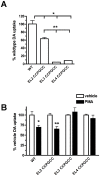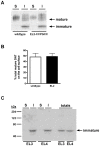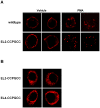Insertion of tetracysteine motifs into dopamine transporter extracellular domains
- PMID: 20161733
- PMCID: PMC2817725
- DOI: 10.1371/journal.pone.0009113
Insertion of tetracysteine motifs into dopamine transporter extracellular domains
Abstract
The neuronal dopamine transporter (DAT) is a major determinant of extracellular dopamine (DA) levels and is the primary target for a variety of addictive and therapeutic psychoactive drugs. DAT is acutely regulated by protein kinase C (PKC) activation and amphetamine exposure, both of which modulate DAT surface expression by endocytic trafficking. In order to use live imaging approaches to study DAT endocytosis, methods are needed to exclusively label the DAT surface pool. The use of membrane impermeant, sulfonated biarsenic dyes holds potential as one such approach, and requires introduction of an extracellular tetracysteine motif (tetraCys; CCPGCC) to facilitate dye binding. In the current study, we took advantage of intrinsic proline-glycine (Pro-Gly) dipeptides encoded in predicted DAT extracellular domains to introduce tetraCys motifs into DAT extracellular loops 2, 3, and 4. [(3)H]DA uptake studies, surface biotinylation and fluorescence microscopy in PC12 cells indicate that tetraCys insertion into the DAT second extracellular loop results in a functional transporter that maintains PKC-mediated downregulation. Introduction of tetraCys into extracellular loops 3 and 4 yielded DATs with severely compromised function that failed to mature and traffic to the cell surface. This is the first demonstration of successful introduction of a tetracysteine motif into a DAT extracellular domain, and may hold promise for use of biarsenic dyes in live DAT imaging studies.
Conflict of interest statement
Figures




Similar articles
-
Introducing tetraCys motifs at two different sites results in a functional dopamine transporter.Acta Biol Hung. 2009 Mar;60(1):15-25. doi: 10.1556/ABiol.60.2009.1.2. Acta Biol Hung. 2009. PMID: 19378920
-
Amphetamine-induced decreases in dopamine transporter surface expression are protein kinase C-independent.Neuropharmacology. 2008 Mar;54(3):605-12. doi: 10.1016/j.neuropharm.2007.11.007. Epub 2007 Nov 22. Neuropharmacology. 2008. PMID: 18164041 Free PMC article.
-
Dopamine transporter endocytic determinants: carboxy terminal residues critical for basal and PKC-stimulated internalization.Mol Cell Neurosci. 2008 Oct;39(2):211-7. doi: 10.1016/j.mcn.2008.06.011. Epub 2008 Jun 25. Mol Cell Neurosci. 2008. PMID: 18638559 Free PMC article.
-
Dopamine transporter endocytic trafficking: Neuronal mechanisms and potential impact on DA-dependent behaviors.J Neurochem. 2025 Jan;169(1):e16284. doi: 10.1111/jnc.16284. J Neurochem. 2025. PMID: 39655745 Review.
-
The dopamine transporter proteome.J Neurochem. 2006 Apr;97 Suppl 1:3-10. doi: 10.1111/j.1471-4159.2006.03719.x. J Neurochem. 2006. PMID: 16635244 Review.
Cited by
-
MAP Kinase Phosphatase 3 (MKP3) Preserves Norepinephrine Transporter Activity by Modulating ERK1/2 Kinase-Mediated Gene Expression.Front Cell Neurosci. 2017 Aug 22;11:253. doi: 10.3389/fncel.2017.00253. eCollection 2017. Front Cell Neurosci. 2017. PMID: 28878626 Free PMC article.
-
Kinase-dependent Regulation of Monoamine Neurotransmitter Transporters.Pharmacol Rev. 2016 Oct;68(4):888-953. doi: 10.1124/pr.115.012260. Pharmacol Rev. 2016. PMID: 27591044 Free PMC article. Review.
References
-
- Beckman ML, Quick MW. Neurotransmitter transporters: regulators of function and functional regulation. J Membr Biol. 1998;164:1–10. - PubMed
-
- Chen NH, Reith ME, Quick MW. Synaptic uptake and beyond: the sodium- and chloride-dependent neurotransmitter transporter family SLC6. Pflugers Arch. 2004;447:519–31. - PubMed
-
- Amara SG, Sonders MS. Neurotransmitter transporters as molecular targets for addictive drugs. Drug Alcohol Depend. 1998;51:87–96. - PubMed
Publication types
MeSH terms
Substances
Grants and funding
LinkOut - more resources
Full Text Sources

